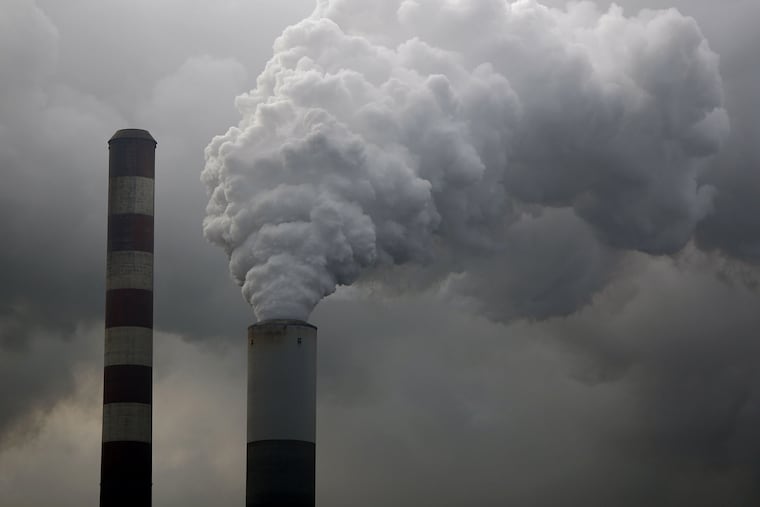As U.S. carbon emissions spike, Pa’s Gov. Wolf announces first statewide reduction plan
An independent research firm released a report Tuesday saying carbon emissions rose a surprising 3.4 percent in 2018.

Pennsylvania Gov. Tom Wolf announced Tuesday he has signed an executive order that sets the first statewide plan to reduce emissions of carbon dioxide, the chief greenhouse gas contributing to climate change.
The goal is to reduce overall energy consumption by 3 percent per year, ultimately by 21 percent by 2025 compared with 2017 levels. The executive order directs the state to replace 25 percent of its passenger car fleet with battery and plug-in electric hybrid cars by the same year, and buy enough renewable energy to offset 40 percent of the state’s electric use.
“In the absence of leadership from the federal government, states and cities are stepping up and doing their part to reduce emissions,” Wolf said in a statement. “Today I am proud to declare the commonwealth’s intention to address climate change, the most critical environmental threat facing the world.”
Earlier Tuesday, researchers released an analysis showing emissions of carbon dioxide spiked in the United States last year, marking the first increase in three years, even though a record number of coal-fired power plants had been retired.
The Rhodium Group, an independent research firm, released a report saying carbon emissions rose 3.4 percent in 2018. The group derived the figure from preliminary emission estimates reported to the U.S. Energy Information Administration in the first three quarters of last year, as well as other data.
The surprising rise suggests the U.S. would need to step up carbon reduction even faster if it has any hope of meeting Paris Agreement goals. The U.S. target has been a 26 to 28 percent reduction of 2005 levels in all greenhouse-gas emissions by 2025. Carbon dioxide amounts to about three-quarters of greenhouse gases produced.
President Donald Trump vowed to pull the U.S. out of the Paris Agreement, but it’s a lengthy process. The earliest possible time frame to formally exit is late 2020.
The U.S. appeared on track to make its second-largest annual gain in emissions since 1996. It saw an increase of 3.6 percent in 2010 as the recession was winding down and industry was gearing back up.
Transportation remained the largest source of emissions. But buildings and industry posted big gains, possibly due to colder weather at the start of 2018 compared with 2017. Yet overall, the first three months of 2018 were still warmer than the average for the quarter in the previous 20 years.
The report notes the increase shows a lack of “limited progress made in developing decarbonization strategies" for buildings and industry.
Indeed, emissions from residential and commercial buildings that use oil, diesel, and natural gas increased by 10 percent, the biggest jump since 2004.
This development marks a significant turnaround in a long trend. Carbon emissions from fossil-fuel combustion peaked in 2007 at 6 million tons. Then, the recession struck and the U.S. increased its use of natural gas, wind, and solar energy. Use of coal-fired plants declined.
Between 2007 and 2015 emissions fell by 12.1 percent, or about 1.6 percent on average each year. Since 2016, the pace of emissions declines has slowed.
To achieve reductions in Pennsylvania, Wolf said, his new GreenGov Council will coordinate with state agencies to reduce energy use and improve energy efficiency in state buildings.
Wolf’s plan drew mixed reaction from environmental groups.
PennFuture applauded it as "an historic step forward that puts Pennsylvania’s aspirations in line with what was negotiated under the Paris Agreement and sends a strong message to Pennsylvanians, the Trump administration, and the rest of the United States that Pennsylvania is committed to tackling climate change and setting a new path for how the Commonwealth produces and consumes energy,” said the group’s president and CEO, Jacquelyn Bonomo.
Joanne Kilgour, director of the Pennsylvania chapter of the Sierra Club, also praised the plan.
But Food & Water Watch says the plan is too timid.
“Pennsylvania can do so much more to combat the climate crisis by moving our state to 100 percent renewable energy by 2035 while creating hundreds of thousands of jobs in a Green New Deal program," said state director Sam Bernhardt. “Governor Wolf, the people of Pennsylvania, and future generations deserve a much more aggressive approach to combating the existential crisis of our time.”
Wolf, who will be sworn into his second term this month, has to work with a Republican-controlled legislature and a House Environmental Resources and Energy Committee led by conservative Rep. Daryl Metcalfe (R., Butler). And Pennsylvania is still a major coal- and natural gas-producing state.
Meanwhile, Gov. Phil Murphy of New Jersey has already set his state on a path to rejoin the Regional Greenhouse Gas Initiative, a market-driven program to reduce carbon emissions composed of Connecticut, Delaware, Maine, Maryland, Massachusetts, New Hampshire, New York, Rhode Island, and Vermont. New Jersey has a Democratic-dominated legislature.